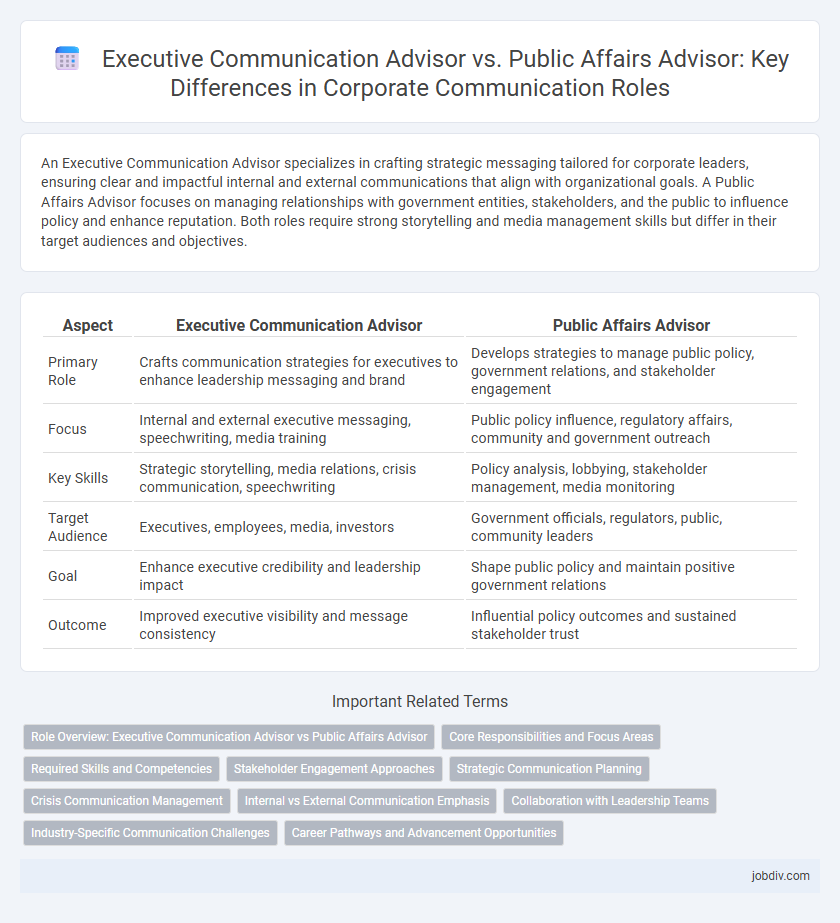An Executive Communication Advisor specializes in crafting strategic messaging tailored for corporate leaders, ensuring clear and impactful internal and external communications that align with organizational goals. A Public Affairs Advisor focuses on managing relationships with government entities, stakeholders, and the public to influence policy and enhance reputation. Both roles require strong storytelling and media management skills but differ in their target audiences and objectives.
Table of Comparison
| Aspect | Executive Communication Advisor | Public Affairs Advisor |
|---|---|---|
| Primary Role | Crafts communication strategies for executives to enhance leadership messaging and brand | Develops strategies to manage public policy, government relations, and stakeholder engagement |
| Focus | Internal and external executive messaging, speechwriting, media training | Public policy influence, regulatory affairs, community and government outreach |
| Key Skills | Strategic storytelling, media relations, crisis communication, speechwriting | Policy analysis, lobbying, stakeholder management, media monitoring |
| Target Audience | Executives, employees, media, investors | Government officials, regulators, public, community leaders |
| Goal | Enhance executive credibility and leadership impact | Shape public policy and maintain positive government relations |
| Outcome | Improved executive visibility and message consistency | Influential policy outcomes and sustained stakeholder trust |
Role Overview: Executive Communication Advisor vs Public Affairs Advisor
An Executive Communication Advisor specializes in crafting strategic messaging for corporate leaders to enhance internal and external stakeholder engagement, focusing on leadership communication, media training, and reputation management. A Public Affairs Advisor concentrates on influencing public policy, managing government relations, and shaping public opinion by navigating regulatory environments and stakeholder advocacy. Both roles require exceptional communication skills but differ in target audiences and objectives, with Executive Communication Advisors prioritizing organizational leadership impact and Public Affairs Advisors emphasizing policy and public influence.
Core Responsibilities and Focus Areas
Executive Communication Advisors specialize in crafting strategic messages and managing communication for C-suite leaders, emphasizing brand reputation, internal alignment, and stakeholder engagement. Public Affairs Advisors focus on influencing public policy, managing government relations, and navigating regulatory environments to support organizational objectives. Both roles require expertise in media relations and message development, but Executive Communication Advisors prioritize internal and executive narratives, whereas Public Affairs Advisors concentrate on external policy communication and advocacy.
Required Skills and Competencies
An Executive Communication Advisor must excel in strategic messaging, leadership communication, and crisis management, demonstrating strong emotional intelligence and the ability to tailor messages for diverse executive audiences. Public Affairs Advisors require expertise in stakeholder engagement, government relations, and media advocacy, with competencies in policy analysis and public sentiment assessment. Both roles demand exceptional written and verbal communication skills, but the Executive Communication Advisor prioritizes internal and executive-level dialogue, while the Public Affairs Advisor focuses on external public perception and regulatory environments.
Stakeholder Engagement Approaches
Executive Communication Advisors utilize tailored messaging strategies that align with C-suite priorities to engage internal and external stakeholders effectively, emphasizing clarity and influence in decision-making processes. Public Affairs Advisors focus on building coalitions and managing relationships with governmental bodies, media, and community groups through strategic advocacy and policy communication. Both roles leverage stakeholder mapping and sentiment analysis but differ as Executive Communication Advisors prioritize organizational alignment while Public Affairs Advisors emphasize regulatory and public opinion dynamics.
Strategic Communication Planning
An Executive Communication Advisor specializes in crafting tailored messaging and media strategies that align with organizational leadership goals, ensuring clear and persuasive communication at the executive level. A Public Affairs Advisor focuses on managing stakeholder relationships and navigating regulatory environments to influence public policy and public perception effectively. Both roles require expertise in strategic communication planning to drive organizational objectives and maintain a positive reputation in complex communication landscapes.
Crisis Communication Management
Executive Communication Advisors specialize in crafting strategic messages and managing internal and external communications to uphold leadership reputation during crises. Public Affairs Advisors focus on navigating government relations and stakeholder engagement to influence public policy and maintain organizational credibility. In crisis communication management, Executive Communication Advisors prioritize clear, consistent messaging, while Public Affairs Advisors leverage political acumen to mitigate reputational risks and manage regulatory impacts.
Internal vs External Communication Emphasis
An Executive Communication Advisor primarily focuses on internal communication strategies, enhancing leadership messaging and ensuring consistent delivery within an organization. In contrast, a Public Affairs Advisor specializes in external communication, managing the organization's reputation and stakeholder engagement with media, government, and the public. The Executive Communication Advisor drives employee alignment and culture, while the Public Affairs Advisor influences public perception and policy advocacy.
Collaboration with Leadership Teams
Executive Communication Advisors and Public Affairs Advisors both play pivotal roles in collaboration with leadership teams, ensuring aligned messaging that supports strategic objectives. Executive Communication Advisors specialize in crafting clear, impactful internal and external communications, enhancing leadership visibility and influence. Public Affairs Advisors focus on navigating regulatory environments and managing stakeholder relationships to support policy goals and reputation management.
Industry-Specific Communication Challenges
Executive Communication Advisors specialize in crafting tailored messages that align with corporate leadership goals, addressing internal and external stakeholder needs in industries such as finance, technology, and healthcare. Public Affairs Advisors navigate regulatory environments, managing communication strategies related to government relations, policy advocacy, and public perception in sectors like energy, pharmaceuticals, and infrastructure. Both roles require deep understanding of industry-specific jargon, compliance requirements, and audience sensitivities to effectively influence decision-making and reputation management.
Career Pathways and Advancement Opportunities
Executive Communication Advisors typically advance through roles in corporate communications, gaining expertise in strategic messaging and leadership communication, often moving into senior executive positions or chief communications officer roles. Public Affairs Advisors progress by developing deep knowledge of policy, government relations, and stakeholder engagement, which can lead to senior roles in government affairs, lobbying, or public policy management. Career pathways for both roles emphasize specialized skills: Executive Communication Advisors focus on internal and external corporate narratives, while Public Affairs Advisors prioritize influence in regulatory and political environments.
Executive Communication Advisor vs Public Affairs Advisor Infographic

 jobdiv.com
jobdiv.com